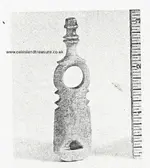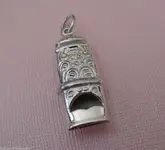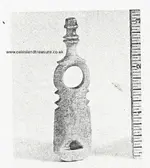Thanks Dave; I was surprised to see the photo you attached as I thought it to be a picture of the 18th century Cornish Poll-Pick!
I did not pay much attention to the pick, and admittedly do not know much about them. I was focused on the coconuts.
Your picture helps to prove that the coconut has been documented to float throughout the oceans of the World, although it does not prove how truckloads of the processed fiber could have arrived at Oak Island.
While we are both citing the same website, I think that there is some difference in what we're citing. I cited a carbon dating report that was over a decade old from a laboratory that's still in business. If there's an entire beach full of literally several feet of stones and coconut fiber, it's time for someone to spend an afternoon with an excavator to put this myth to rest. I have seen a handful of fibers recovered on film (admittedly on a reality TV program), but I'm not seeing the large amounts that are supposedly there. The report states that this is lining the whole beach, but if they did not excavate the whole beach then how could they know this? And if they did excavate the whole beach, where are the rest of those fibers?
Your arguments did make me take another look and view as to how 2 or maybe 3 carbon testings could arrive with the 14th century as the probable date for this fiber. I along with the scientist who documented the history of the Coconut still believe that there was not a flourishing coconut industry outside of Malaysia prior to the 1700's ad.
The? I was under the impression that there was more than one. Who is this person?
My theories can be changed based on evidence provided.
As can mine. As have mine, in this case. I used to be very skeptical about old coconut fibers at the site. As it turns out, they were there. I'm still not sold on the quantity and I'm not prepared to speculate on the source(s), but it's something that I have to accept now.
Where I believe other's and I eroded was in presuming that in the 18th century there was an industry in the Caribbean and Central America producing coconut fiber and these fibers came from this part of the World. It makes more sense that Spanish ships from the East Indies carting supplies and trade to Havana would off load and store this packing material prior to taking gold shipments back to Spain. Mr. Harris's letter (attached) states his believe that these fibers originated in the East Indies. The Keppels would have had boat loads of this material readily available for their plans at Oak Island. This allows for the carbon dating of the Coconut Fibers to be 14th Century...
I'm not sure about an operation utilizing dunnage that was several centuries old. It's not beyond the realm of possibility, but I'd say that it's unlikely. The timeline for coconut propogation established in your last post would have made a West Indian origin impossible.
...while all other stated found items (Wood Pieces and Wood Platforms, Block and Tackle, Cornish Poll-Pick, Axe, Scissors, Shoe, Parchment Paper, Ruler, Anchor Flute, Nails, Metal Fragments, Chain and Boatswain Whistle) compatible with the 18th century, and conform with the Freemasons as builders of The Money Pit at Oak Island.
The majority of these artifacts (if they did indeed exist) are poorly documented and cannot be taken as evidence at face value.
It still also disqualifies Vikings, Knight Templars and Druids as possible builders, as they did not have access to this quantity of fibers in their time period.
I won't argue that the Vikings, Templars, or Druids were not involved. As for fibers, that's another story entirely. "One Thousand and One Nights" predates 1200 AD and mentions Sinbad gathering and selling coconuts. Was coir known in the middle east during this time? Maybe and maybe not, but coconuts certainly were; as a bonus, they would have travelled well as trade goods and would have been immediately useful to the people transporting them in a variety of ways. It's likely that these stories date back to 1000 AD or earlier. Would coconuts have been available in the Holy Land at that time? That's not an area that I've researched and I don't have an opinion, but they could have been, and if they were, Europeans would have had access to them.
Now it gets weird...if coconuts had made it to the Holy Land by then, might they have even made it to Constantinople? It made its money by serving as a trading hub. By 1000 AD, the rulers of the Byzantine Empire had been protected by the Varangian Guard for over a century. The Varangians, of course, were mostly Scandinavians during this period of time. Can you imagine Norsemen and Icelanders drinking coconut water a thousand years ago? It boggles the mind. Did it happen? I don't know that it did, but it could have, and I find that concept to be astonishing. This is admittedly a bit of speculation on my part, but it's completely plausible.
Falling back to a substistance farmer sort of mindset, I would say that if my environment supported coconuts, I would be growing the hell out of them. It is an amazingly useful fruit, produced by a fairly useful tree. No wonder it got around like it did!



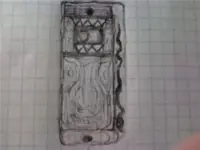
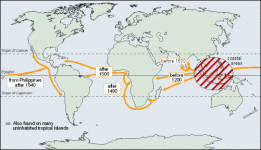

 Fufills most requirements far more closely, if not completely. NO
Fufills most requirements far more closely, if not completely. NO


